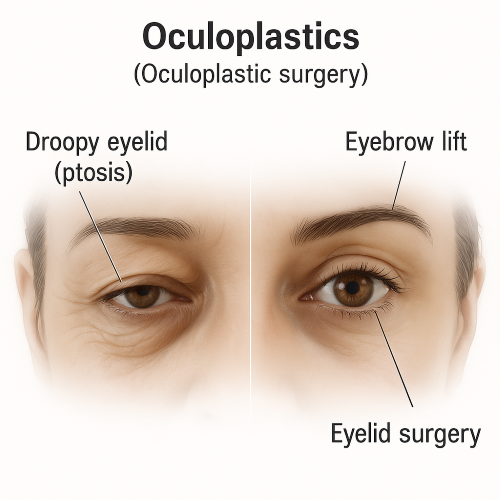Droopy Lids, Blocked Tears or Eye Discomfort? How Oculoplastic Surgery Restores Comfort & Function

When we think about eye care, we often focus on vision — how clearly we see, whether we need glasses, or if our eyes feel tired. But did you know there’s a specialised area of eye care that goes far beyond just sight? It’s called oculoplastic surgery — a unique field that blends medical expertise with surgical precision to treat the delicate structures around your eyes, including your eyelids, tear ducts, and eye sockets.
Oculoplastic surgery isn’t just about improving how you look — more importantly, it restores comfort, supports eye function, and relieves chronic issues caused by structural problems around the eyes. Whether you’re recovering from an eye injury, managing chronic tear duct issues, or experiencing age-related eyelid changes that affect your vision or comfort, oculoplastic care may offer relief and restore quality of life.
Let’s explore this fascinating field with Dr. Nazila, Consultant Ophthalmologist & Oculoplastic Surgeon at Sunway Medical Centre Velocity, and discover how oculoplastic surgery can help you not just see better — but feel better, too.

What Is Oculoplastic Surgery?
Oculoplastic surgery is a specialised subfield within ophthalmology that focuses on the delicate structures around the eye — including the eyelids, tear ducts (lacrimal system), orbit (eye socket), and the upper to mid-face. It combines reconstructive and cosmetic techniques to restore function, relieve discomfort, and address conditions that affect the appearance or movement of these areas.
As we age, the muscles and tissues supporting the eyelids may weaken. This can lead to droopy eyelids (ptosis), inward- or outward-turning lids (entropion or ectropion), lashes rubbing against the eye, persistent tearing, or even eyelid growths. These issues are more than cosmetic — they may cause significant discomfort, blurred vision, or increase the risk of infections and long-term complications.
Common Conditions Treated by Oculoplastic Surgeons
You might be surprised by how many day-to-day concerns can be addressed through oculoplastic procedures. Some of the most common include:
-
Droopy eyelids (Ptosis) – Often age-related or due to weakened eyelid muscles; may obstruct vision or cause eye fatigue.
-
Eyelid malpositions – Such as entropion (lid turns inward) or ectropion (lid turns outward), leading to irritation, tearing, or dryness.
-
Blocked tear ducts – Causing excessive tearing or discharge due to poor drainage.
-
Eyelid trauma – Includes both recent injuries and old damage that may require surgical correction.
-
Benign or malignant eyelid tumours – Such as cysts, warts, or skin cancers requiring removal or biopsy.
-
Eye socket (orbital) issues – Including sunken eyes or fractures that affect appearance or function.
-
Congenital eyelid abnormalities – Especially in paediatric patients, such as ptosis or malformations present at birth.
-
Reconstructive needs after eye removal or tumour surgery – Including preparation for prosthetic eyes.

What to Expect During Surgery
Depending on your condition, oculoplastic procedures may be performed in a day-care setting under local or general anaesthesia. Some surgeries are quick and straightforward, while others may require more detailed planning, imaging, and recovery.
During your consultation, the doctor will assess not only the cosmetic aspects but also how the issue affects your daily comfort and eye health. A personalised plan will then be developed to address your specific medical and aesthetic needs.
Treating Blocked Tear Ducts
If your eyes are constantly tearing or you often notice discharge near the inner corners, it might be due to a blocked tear drainage system. In many cases, surgery can restore normal tear flow by creating a new drainage pathway or enlarging the duct openings. These procedures are typically done with minimal downtime and can greatly reduce discomfort or the risk of infection.
Is Oculoplastic Surgery Safe?
Oculoplastic surgery is generally very safe when performed by trained and experienced professionals — typically ophthalmologists with sub-specialty training in oculoplastics. However, as with any surgery, there are potential risks, such as:
-
Bruising or swelling
-
Infection
-
Bleeding
-
Temporary or, rarely, long-term visual disturbances
These risks are minimised through careful pre-surgical assessment, planning, and post-operative care. You’ll also receive detailed instructions on how to manage your recovery at home.
More Than Meets the Eye: How Function Affects Daily Life
While oculoplastic surgery is sometimes associated with aesthetics, its true impact lies in restoring everyday function. For many patients, it relieves physical discomfort and prevents long-term eye issues — whether it’s correcting an eyelid that can’t close fully, treating recurrent eye infections from blocked tear ducts, or repairing damage after injury or tumour removal.
Final Thoughts
If you’ve been experiencing droopy eyelids, excessive tearing, growths near the eye, or difficulty closing your eyes fully, it may be time to seek professional care.
At Sunway Medical Centre Velocity, our oculoplastic surgeon provides comprehensive evaluation and treatment for a wide range of functional conditions around the eyes. With a personalised and patient-centred approach, we’re here to support your journey — from diagnosis to recovery — so you can regain comfort, vision, and confidence in daily life.
To schedule a consultation or learn more about our Eye Care Services, click here.
Was this article helpful?
2 out of 2 found this helpful
Suggest to Read









